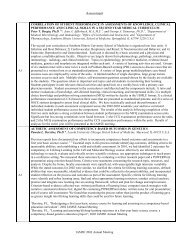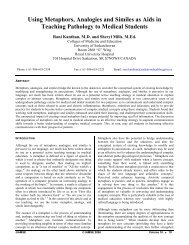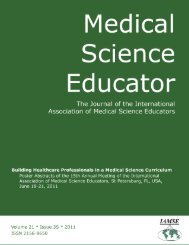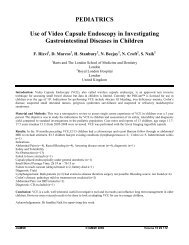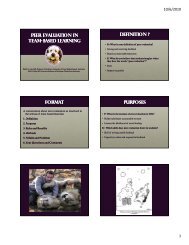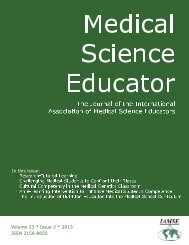Click here to view complete journal in pdf-format - IAMSE
Click here to view complete journal in pdf-format - IAMSE
Click here to view complete journal in pdf-format - IAMSE
Create successful ePaper yourself
Turn your PDF publications into a flip-book with our unique Google optimized e-Paper software.
Professional Development Abstract ID: 202<br />
RELATIONSHIP CENTERED-CARE AND<br />
THE HIDDEN CURRICULUM AT ROSS<br />
UNIVERSITY SCHOOL OF MEDICINE.<br />
Diana Callender 1 , Manj<strong>in</strong>der Pannu 1 , Stacy D<br />
Emile 1 , Donald Leveille 1 and Richard Frankel 2<br />
1 Department of Integrated Medic<strong>in</strong>e, Ross<br />
University School of Medic<strong>in</strong>e, Dom<strong>in</strong>ica 2 Indiana<br />
University School of Medic<strong>in</strong>e, USA<br />
PURPOSE<br />
Ross University School of Medic<strong>in</strong>e (RUSM) is<br />
comprised of a diverse mix of North American<br />
students, an <strong>in</strong>ternational faculty and a primarily<br />
native Dom<strong>in</strong>ican staff. T<strong>here</strong> are tensions between<br />
the slower-paced Dom<strong>in</strong>ican life-style and culture<br />
and a results-oriented American <strong>in</strong>stitution, and<br />
defensiveness among the different groups.<br />
METHODS<br />
In 2008, five RUSM representatives, <strong>in</strong>clud<strong>in</strong>g<br />
faculty, staff and students, attended a Conference at<br />
Indiana University School of Medic<strong>in</strong>e <strong>to</strong> learn<br />
techniques for promot<strong>in</strong>g a relationship-centered<br />
environment at RUSM. A “Discovery Team” was<br />
formed and conducted more than 40 <strong>in</strong>ter<strong>view</strong>s<br />
us<strong>in</strong>g appreciative <strong>in</strong>quiry (AI), a strengths-based<br />
organizational change approach.<br />
RESULTS<br />
AI s<strong>to</strong>ries from upperclassmen are now presented <strong>to</strong><br />
<strong>in</strong>com<strong>in</strong>g students at the white coat ceremony.<br />
Barazas (Town Hall Meet<strong>in</strong>gs) are held<br />
approximately each semester and new s<strong>to</strong>ries are<br />
<strong>to</strong>ld and circulated. Members of the Student<br />
Government Association have been <strong>in</strong>troduced <strong>to</strong> AI<br />
and, at their recommendation, a student club <strong>to</strong><br />
promote AI is be<strong>in</strong>g formed. Thematic analysis of<br />
the s<strong>to</strong>ries shows that t<strong>here</strong> is a well-spr<strong>in</strong>g of<br />
faculty and staff commitment <strong>to</strong> student success,<br />
and that students support one another.<br />
CONCLUSIONS<br />
Positive strides <strong>to</strong> close the gap between the<br />
different cultures at RUSM have been taken with the<br />
<strong>in</strong>troduction of AI, the use of Barazas, and the<br />
presentation of AI booklets <strong>to</strong> <strong>in</strong>com<strong>in</strong>g students.<br />
Cont<strong>in</strong>ued success could impact the hidden<br />
curriculum and <strong>in</strong>crease its congruence with<br />
teach<strong>in</strong>g about professionalism and relationshipcentered<br />
care <strong>in</strong> the formal curriculum and student,<br />
faculty and staff <strong>in</strong>teractions. Adm<strong>in</strong>istrative<br />
support has been <strong>in</strong>valuable, but <strong>in</strong>creased success<br />
will depend require more student, faculty, and staff<br />
champions.<br />
Professional Development Abstract ID: 203<br />
A HEALTHCARE INTERACTIVE MATRIX TO<br />
IMPROVE PATIENT OUTCOMES AND<br />
INTERPROFESSIONAL TEAMWORK<br />
Herbert Janssen 1 , Jason Wasserman 2 , C<strong>in</strong>dy<br />
Ac<strong>to</strong>n 3 , and Josef<strong>in</strong>a Lujan 4 Paul L Foster School of<br />
Medic<strong>in</strong>e 1 , Gayle Greve Hunt School of Nurs<strong>in</strong>g 4 ,<br />
Anita Thigp<strong>in</strong> Perry School of Nurs<strong>in</strong>g 3 , Texas Tech<br />
University Health Sciences Center Department of<br />
Biomedical Ethics 2 , Kansas City University of<br />
Medic<strong>in</strong>e and Bioscience, USA<br />
PURPOSE<br />
Interprofessional teamwork is def<strong>in</strong>ed as a<br />
collaborative <strong>in</strong>teraction among <strong>in</strong>traprofessional<br />
team members <strong>to</strong> provide quality, <strong>in</strong>dividualized<br />
care for patients. However, previous approaches <strong>to</strong><br />
teamwork have been criticized as overly simplify<strong>in</strong>g<br />
a complex <strong>in</strong>teractional process. This work<br />
<strong>in</strong>vestigates these <strong>in</strong>teractions us<strong>in</strong>g a formalized<br />
matrix that can nonetheless account for the<br />
complexity <strong>in</strong> the relationships between the patient,<br />
their family, and the healthcare team.<br />
METHOD<br />
The matrix was developed de novo us<strong>in</strong>g a multicriteria<br />
decision-mak<strong>in</strong>g (MCDM) approach,<br />
<strong>in</strong>corporat<strong>in</strong>g the knowledge and attitudes of the<br />
patient and the various healthcare providers. It<br />
comb<strong>in</strong>es traditional team member roles and<br />
explores ways these could be altered <strong>to</strong> improve<br />
patient outcome and <strong>in</strong>terprofessional <strong>in</strong>teractions.<br />
RESULTS<br />
The proposed matrix considers the patient's illness<br />
and emotional needs on a cont<strong>in</strong>uum. Professional<br />
abilities are matched with the emotional need of the<br />
patient and their support group. The dynamic<br />
nature of the matrix allows it <strong>to</strong> consider the<br />
knowledge, skills, and expectations of the<br />
stakeholders as they change with each patient.<br />
CONCLUSIONS<br />
Use of the healthcare <strong>in</strong>teractive matrix provides a<br />
new approach <strong>to</strong> maximize the quality of healthcare<br />
delivery by del<strong>in</strong>eat<strong>in</strong>g roles and their <strong>in</strong>teractions<br />
<strong>in</strong> a way that promotes comprehensive care. For<br />
example, it promotes physician concern for the<br />
patient's emotional needs while ma<strong>in</strong>ta<strong>in</strong><strong>in</strong>g the<br />
required objectivity. It also recognizes the nurse's<br />
ability <strong>to</strong> support the patient and other caregivers,<br />
<strong>in</strong>clud<strong>in</strong>g family, while also provid<strong>in</strong>g medical care.<br />
Similarly, it accounts for the family member's social<br />
supportive role, while at the same time recogniz<strong>in</strong>g<br />
their need for health and medical <strong>in</strong><strong>format</strong>ion about<br />
their loved one. The <strong>in</strong>teraction of other healthcare<br />
providers can be <strong>in</strong>serted <strong>in</strong><strong>to</strong> the matrix as team<br />
Medical Science Educa<strong>to</strong>r © <strong>IAMSE</strong> 2012 Volume 22(4S) 317



